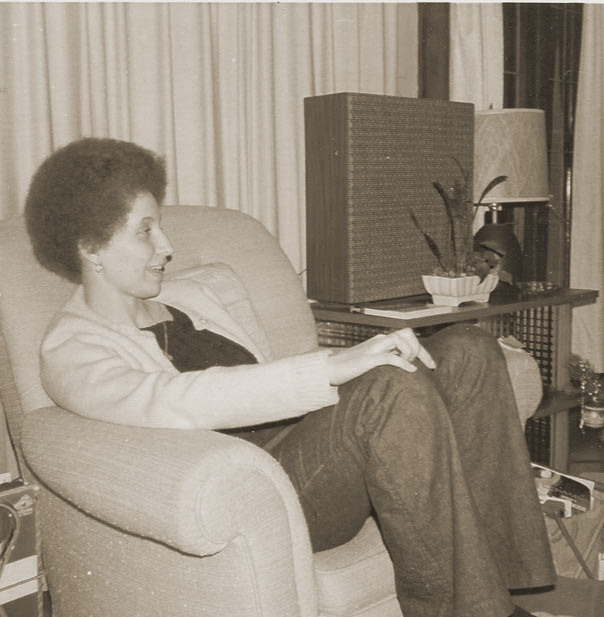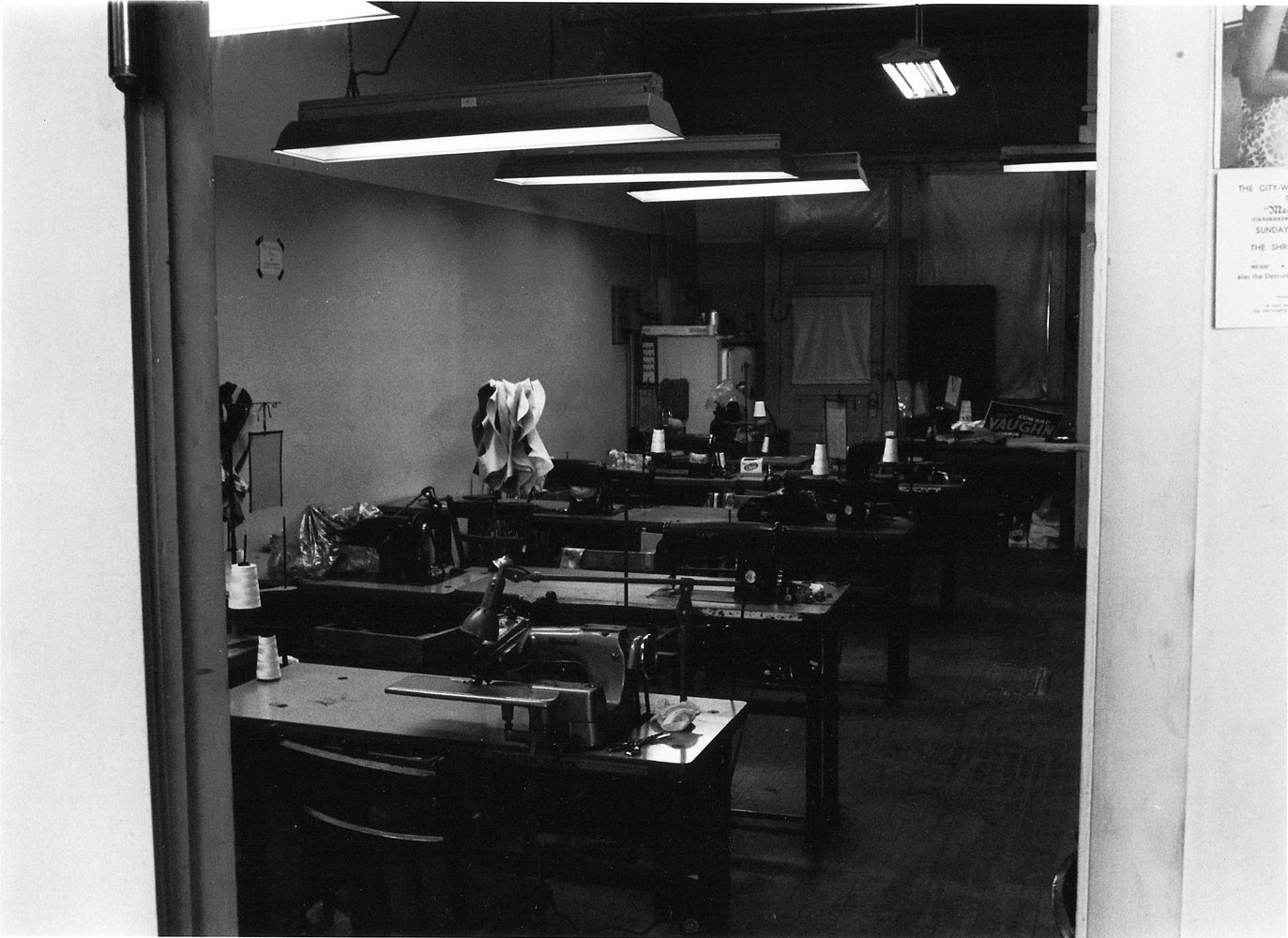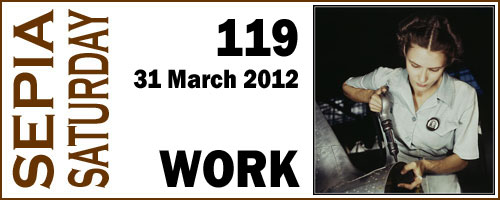I graduated with a BFA in December of 1968 and caught the Greyhound bus out of town right after Christmas. At the time, it was the only way I could figure out to leave home. My true love was living with someone else. My parents would not look kindly on me moving to my own place in Detroit, so I hit the road. I first went to San Francisco. Stayed about a week. The person I knew out there had returned to Mississippi. Decided to head to Washington D.C. where my sister was a student at Howard. I hadn’t enjoyed the 5 day bus ride out so I caught the train east. I stayed in my sister’s dorm room for a week or two, until one of her play writing teachers hooked me up with a friend of his in New York City, a woman from Belgium who taught French at Columbia University.
I caught the train to NYC and took a cab from Grand Central Station to her apartment on Riverside Drive. I remember looking out of the apartment window one evening, listening to Joni Mitchell singing “I’ve looked at Clouds” coming from another apartment. I stayed with her a week or two, got a job doing clerical work. Met some of her friends. Tried hash. Whoa. Moved to the YWCA when her mother came for a visit. Went through the blizzard of 1969. Got a letter from Jim and decided to go back to Detroit. I took a plane.
Some first thoughts on arriving back were that Detroit was the dirtiest place I’d been. Gray and dirty. I moved back in my mother’s and got a job at the newly opened Church sewing factory. It was just the sort of job I wanted. I didn’t have to give it any thought so I could devote my mind to planning and plotting other things. There were only about 4 of us working there, sewing African print “mod” clothes. I felt a connection to my seamstress ancestors while working there.
Several weeks later, I moved out, much to the consternation of my parents, especially my mother, who would have rather I discussed it with her first instead of the late night call I made telling her I wouldn’t be coming home. After staying in the Black Conscience Library for a few days (there was a living quarters), I found an apartment and discovered it wasn’t that hard to move out and be on my own. I felt a great weight off of my mind, being on my own. I worked there sewing for almost a year before leaving to become a revolutionary librarian and have my first daughter. I was 22.




You seemed fearless in your search for???? You were blessed with options and capabilities. You seemed to have never limited your choices. Your chronicles are rich from your experiences.
Once I figured out I could actually be on my own I guess I did keep working to do whatever I thought I needed/wanted/would be good to do.
That is so well written (and illustrated) it was like we were sitting together and chatting and you were sharing the story of your life. It’s good writing and not easy to do.
Kristin,
This is the kind of post I’m convinced will be so appreciated by your descendants. They will have a much better idea of who you are — and so do I. The confidence in your smile tells it all. It’s obvious that you did it your way. But what is a revolutionary librarian?
I sense that revolutionary means slightly rebellious in this case. What a single-minded woman you are, and you started at an early age! What memories to pass on.
Haven’t read any blogs in awhile- so this is a fabulous post to begin reading again! Just loved it. And you!
Thanks Zann! glad you read it.
Such a beauty and such a life well lived. Rock on!
awww, Elaine. thanks.
love this stuff! you did it the smart way!
I don’t know if it was the smart way or not, but I did it anyway 😉
I so love this. I get such a clear picture of that you have lived your life on your own terms. Brilliant writing!
Someday I will have to tell the story of how I was before I left on my cross country trip.
Alan, maybe it helped to wait until almost midnight to write it and just do it in one fell swoop.
Kathy and Nell, a “revolutionary librarian” is not merely a rebellious daughter. Jim,(eventually my husband) came up with the idea of a library that would focus on bringing information to the black community during those days of riots and self awareness and black pride that would answer the questions “The situation of the black man.”, “How we got into this situation”, “How we are kept in this situation” and “How we can get out of this situation”. There was a small group of us that kept it going. There were classes that dealt with the quesitons above. I showed movies like “The Battle of Algiers” and others dealing with black awareness. Sometimes I did a series for children with movies like “Snowy Day”. There were newsletters put out that dealt with busing (“F*&K Busing” was the title of that one) and police brutality. I ran the small Gestener mimeograph machine and did layout and typing. We silk screened posters. Some advertised events. Some, like the “Revolution Begins in the Mind” poster, you can see a messed up copy on the wall in the photo above, we did for educational purposes and put up around town. I remember designing a Malcolm X montage poster which was printed elsewhere and sold to raise money for the library. I also ordered books. There was at one point a rifle club that went to the range on the weekend. I think I will have to do a post specifically devoted to those days. Perhaps there will be a “library” or “revolution” prompt at some point.
Great post and I enjoyed reading your extra information in the comments.
I am even more in awe of your life after reading the comments as well as the post. Your determination and courage ahine through. Truly admirable!
I think I’m really lucky that nothing disastrous happened to me during those times.
Kris, every time that I think that I know you, you come up with something like this wonderful story, which proves that I don’t!
I first visited the Black Conscience Library in 1969 or ’70. Of course, I had no clue of all that had been going on in the life of the beautiful woman running the 16mm film projector! That’s where I saw “The Battle of Algiers” and Newsreels’ Black Panther party short films.
I’m really glad that I was able to send you the photo of the Black Star clothing factory. I love all of the photos that you used, which are made more meaningful by the context that you provided.
I assume that this story is only part of the memoir that you’re working on (hint, hint).
It’s no wonder that I claim you as a big sister! Who wouldn’t?!
And thank you again for sending me that great photo. I thought there was one taken in the Cultural Center basement too but I can’t find it.
I think that you’re remembering the color VIDEO that we have of the Black Star clothing factory, as Ed Vaughn named it, after it moved to the basement of the Shrine of the Black Madonna #1 Cultural Center and Book Store on Livernois, just north of Davison. Lemme know if you’d like me to make vidcaps of it — although you have the DVD.
Kris, the photo of the original factory would’ve meant little to me without the wonderful stories that you told me about it, including WHERE it was located. Because of you, I learned that your Aunt Gladys also worked there.
Everyone who’s posted on this blog agrees that you have a very rich life. So, you working on a memoir or what? Of course, if you are, I’d be honored to help in any way that I can.
P. S.: I just got a copy of the new “Black Power Mixtape” documentary. The stupid Swedish filmmakers didn’t have a clue of what that wonderful late 1960s and early ’70s footage was and the “commentaries” by supposed movement veterans and observers are all but worthless.
However, you should know that the footage of Jim working in the “Inner City Voice” office in late 1967 made it into the film.
I’ll look for the video. We called it the Black Star Clothing Factory when it was located off of Joy Road too.
That bottom pic looks like it was taken at Shrine 1. I’m I correct or not?
No, it wasn’t at Shrine 1. It was taken in the Black Conscience Library on Linwood and Elmhurst.
I’m absolutely dizzy after reading your post. Your quest to find the perfect place, going from one place to another was exhausting. I can see why the job at the sewing factory was such a peaceful experience for you. The nice hum of a sewing machine can cure all those evils.
Nancy
Nancy, the trip wasn’t exhausting. Interesting though. What I was looking for was something that wasn’t school, where I could think about what I wanted to think about and not classes like Aesthetics for instance.
Wow, you had some amazing experiences. The 60’s were such a heady time. I’m a little younger than you– and all of the energy was gone by the 70’s. I can remember once telling my mother that I wished I’d been in college during the 60’s. She was horrified, but I still think that I missed something.
I was in college from 1964 through 1968. It was an interesting time to be young. By 1972 much of the energy and the groups were gone. I never realized it wasn’t just in my life that this happened but across the board.
Beautiful photographs, remarkable life. You appear so relaxed in the photograph waiting for the bus.
I look that way in all the photos taken that night.
Terrific personal history. A privilege to read this. Thank you. My first journalism job was writing for the Liberation News Service in N.Y.C., when it was well past its heyday (c. 1978), but still felt like something I had to be a part of. Wrote about the Newark Teachers Strike.
We used to subscribe to Liberation News Service. Always interesting.
There can’t be many people who had a job as a revolutionary librarian. I seems like the complete opposite of sewing.
I might have been able to leave one time, but I doubt I could have handled the criss-crossing of the country and the uncertain living quarters like you did. You earned a living through work but you made a life.
I’m so glad you share these little pieces of your life that no one knows but you… would love to read these as a book, on paper like the Nick Bantock books… with pockets, post cards, letters and journals…
Ife, somehow I thought you all knew this. I might have to doctor the journals and letters…
I love that picture of you waiting for the bus…it’s so 1968.
That was quite a leap…from the sewing factory to the revolutionary library!
I worked as counselor of a church group of teen- aged girls in Watts right before and after the Watts Riots in L.A. This was a few years before 1968. It was a heady, interesting, valuable era. Then, of course there were the anti- war marches. It definitely was a revolutionary time. I’m glad I experienced it all.
It probably wasn’t as much of a leap as it seems. The sewing factory was attached to my fathers black nationalist church. I’m glad I experienced it all too.
And I was working at the library in my off time anyway.
Barbara, I’m a historian and would like to ask you a few questions about Watts during the period that you worked there. I visited your blog, but couldn’t find anyway to contact you. If you would, please write to me at my email address: beistorage17@yahoo.com. Thank you.
Great photos and story. Sewing machines and social revolution have a long history.
Fascinating read…the sixties must have been an interesting time to be a young person. I admire your adventurous, free spirit. Great pictures too!
This would make a fascinating ‘story’ to read; the fact that it is true makes it even more amazing. What a sheltered life so many of us had.
You were so fearless and determined. I’m so glad you shared this story with us.
The epitome of the great stories of the 60s. Taking chances, expanding your world. Loved it.
I admire the honesty in the description of your journey. As a creature of comfort, I shuddered at some details. I like my comfort and privacy. You were a woman of little needs!!! I’ll never look at librarians ever the same way!!
😉
HUGZ
I will have to admit that comfort and privacy weren’t at the top of my list on this journey.
That is great that you were brave and traveled around and saw most of the US all at once. You look so pretty and happy there in the library, waiting for your baby to be born. Was there enough light in that sewing room?
Thanks for this wonderful post,
Kathy M.
There was plenty of light and each sewing machine had a light attached to it, bigger than a home sewing machine light.
Wow! I’d say a memoir is just bursting to be written. The best part is you’re a damn good writer!
Coincidence moment — I was watching a documentary on PBS last night called “The Triangle Fire” about the beginnings of the labor movement in the garment industry and the fire in one of the factories that killed so many young women. It showed what revolution can do.
Kristin, I love this post — your writing is wonderful — the photos are ideal — and you are one brave woman!!
Now — about that hash …
Peace …
Ron, I think you’re right about the memoir and I even organized my material several years ago. Maybe I need to forge ahead.
Lucky for me the Black Star Clothing factory was on the ground floor and we never had a fire. And now the garment industry has mostly left here and gone to places without unions.
The hash was a one shot thing. I never got into even weed. And it’s a good thing because I think I would have just lay around listening to music.
A confident young woman, determined to forge her own way in the world 🙂 Love your photos, Kristin. When I dropped out of College (chose the wrong course) I got a job as a typist in a typing pool. I liked the mindless work as I could make plans for the future while typing whatever the tape told me. I discovered my brain could type without hearing, and think about other more important stuff while I made the £ to pay the bills!
I did have to think about the sewing a bit so as not to sew up my fingers but I never had to think about it when I wasn’t there and I like doing things with my hands.
Oh how I love this post. I love your adventurous spirit, the way you write this, the matter of fact voice sharing such extraordinary details. I want more more more.
I will try to write more about my life. Planning to write some about libraries in my life Saturday and next week.
i love you!
gem!
And I, you.
Brilliant, Kristin! You have lived a rich life. I have to admit a certain sympathy for your mother as I watch my own children make their way out into the world. But your example encourages me (mostly…).
My mother was a bit judgmental and you don’t strike me as being that way. Raising children is fraught with worry, even when things seem to be going well. I picture your children doing fine, Susan. And your grandson growing up to do it all over again 😉
You wrote this before I started participating in Sepia Saturday, so I’m glad I stumbled on it today. You always write with honesty. Some of your stories we can all identify with (how to leave home and be on your own as an adult) and some are far removed from my personal experience – like being a revolutionary librarian and working in a sewing factory attached to your father’s black nationalist church. So I love hearing about your life in your words and with your pictures. Like Sheryl commented above, I always felt like I was born a few years too late. All the energy was gone by the time I entered college in the fall of 1971.
I’m glad you found it Kathy. Yes, by 1971 things on campus weren’t the same as they were in the 1960s.
I think the wind got knocked out of everyone’s sails when Malcolm X, Martin Luther King Jr., and Bobby Kennedy was killed, and then Nixon became President. Most of us put on suits and quietly took the revolution into our everyday lies and jobs. We knew the Vietnam War would not end until Nixon got elected the second time.